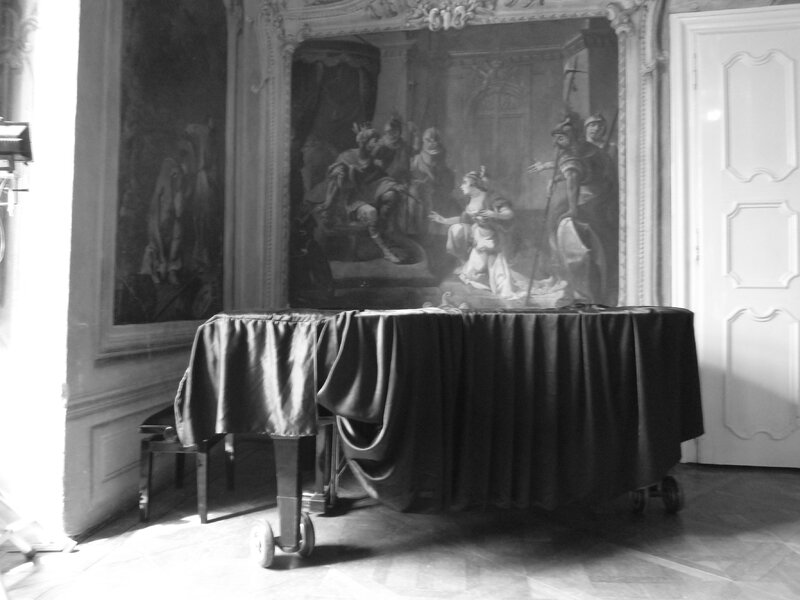LDP 2015 : Carnet de route #9

Sárvár, ouest de la Hongrie : notre LDP Trio se rapprocherait-il (dangereusement ?) de la frontière autrichienne ? Et si oui, dans quel but ? Serait-ce pour poser à propos du public la question qui en effet interroge : en concert, écouter ou filmer ? Sinon, pour s'exclamer : « encore un Yamaha ! »
![]()
30 avril, Sárvár, Hongrie
Nadasdy Ferenc Muzeum
Concert in the museum in the old castle, well, not soooo old. Highly decorated large room, probably for receptions in the olden days, good acoustics, about 30 people, mostly old but a few 40's or under. And a situation that is maybe becoming uncomfortable. In this country, which is basically still a 2 wheel suitcase one, the internet + instant life + affordable rather high-tech gear is making for a particular situation for us, the live performer. Last night was like a film shoot, or photo session, with a live public. It seemed like the majority of the people were there to film, not to listen to the music. And they take the liberty to move around the hall, get a better position, stand in front of their fellows (maybe not on purpose). It put me into a place that is not so comfortable, that I am going to be on Youtube or Facebook or somewhere else public that I didn't chose to be in/on probably before the concert is even over. So, I carry on. Twirl the bass in the air. Stand on my head. Speak in tongues. Still improvising mind you. I think that I have to consider joining the ranks of the difficult, the KJ's of the stage, and forbid filming and photographing during the concert. We could hold a photo session before we begin playing, make all kinds of grimaces and other body language moves that the Facebookers can catch.
In the meantime Black Bat was flying all over the room, pooping here and there.
B.Ph.
Heute spielen wir im Nadasdy Ferenc Museum in Sarvar. Der Konzertraum besteht aus einem altertümlichen Saal aus dem 18. Jahrhundert mit mittelalterlichen Wandgemälden aus der Barock Zeit. Der überakustische Raum bietet eine ausgesprochen transparente Akustik. Einige der Zuhörer kommen offensichtlich nicht nur um zu hören. Sie fotografieren und filmen Teile des Konzerts. Höchstwahrscheinlich sind auf dem Internet bald Spuren dieser Momentaufnahmen zu sehen und zu hören. So können heute live Aufführungen über Internet Streams dokumentiert und öffentlich zugängig gemacht werden. Musik ist und bleibt jedoch ein einmaliges live Erlebnis. An diesem Abend hatte ein vornehmlich älteres Publikum den Zugang die gespielte Musik direkt zu erleben. Die Reaktionen waren enthusiastisch. Die Leute waren berührt und begeistert. Danach hielt in Sarvar wieder die Stille Einzug.
U.L.
Encore un Yamaha dans la grande salle du château Nadasdy. Un C7, no 1863365, qui, bien que localisé à Sarvar, appartient à l'opéra de Budapest. De belles basses, rondes, à la fois profondes et claires, qui se marient étonnamment avec l'acoustique très réverbérante du lieu. L'accordeur y est peut-être pour quelque chose : les meilleurs accordeurs sont ceux qui n'accordent pas le piano en tant que tel, mais ceux qui l'accordent avec la salle, travaillant sur la rencontre entre les propriétés acoustiques de l'espace et le son du piano. A mes mots élogieux sur les graves de l'instrument, l'organisateur sourit et me dit les commentaires critiques d'un célèbre pianiste de jazz hongrois qui jugea ce piano déséquilibré précisément à cause de l'ampleur de ses sons graves. Ce « déséquilibre » pointé par d'autres est précisément ce qui m'a plu et attiré chez cet instrument. J'ai aimé son hétérogénéité sonore, profitant au maximum de chaque différence. Un « bon » piano est habituellement d'une homogénéité presque terrifiante. Cette homogénéité, associée au tempérament égal a permis la création d'oeuvres musicales qui ont marqué l'histoire, mais l'écoute a changé. La technologie de l'enregistrement, des artistes comme Luigi Russolo, plus tard John Cage, ont remis profondément en question notre rapport aux sons. C'est pour cela que jouer le piano aujourd'hui, quelque soit le piano, ce n'est pas seulement jouer un instrument, c'est pénétrer un espace, avec ses pavés bien alignés, mais aussi avec sa face cachée, ses zones de non-droit, ses herbes folles et proliférantes.
J.D.
![]()
![]()
Photos : Jacques Demierre.

/image%2F1230432%2F20240303%2Fob_c69251_1280.gif)
/image%2F1230432%2F20240302%2Fob_e9fd85_disque-copy.jpg)
/image%2F1230432%2F20240302%2Fob_e48cec_interviews.jpg)
/image%2F1230432%2F20240302%2Fob_70c886_concerts.jpg)
/image%2F1230432%2F20240302%2Fob_1d8d17_disques.jpg)
/image%2F1230432%2F20240303%2Fob_9de6e6_livres-logo.jpg)
/image%2F1230432%2F20240302%2Fob_45a655_films.jpg)
/image%2F1230432%2F20240303%2Fob_78eeb7_en-librairie-logo.jpg)
/image%2F1230432%2F20240414%2Fob_8eca8d_ff-recto.jpg)
/image%2F1230432%2F20240302%2Fob_8c09bc_sonic-youth.jpg)
/image%2F1230432%2F20240302%2Fob_ae09ee_screenshot-2024-03-02-at-17-15-20-guil.png)
/image%2F1230432%2F20240302%2Fob_76cbf0_couv-grisli.jpg)


/https%3A%2F%2Fstorage.canalblog.com%2F60%2F95%2F335931%2F133790244_o.jpg)
/https%3A%2F%2Fstorage.canalblog.com%2F01%2F53%2F335931%2F132662218_o.gif)
/http%3A%2F%2Fstorage.canalblog.com%2F38%2F48%2F335931%2F132460885_o.png)
/http%3A%2F%2Fstorage.canalblog.com%2F67%2F55%2F335931%2F131019674_o.jpg)
/image%2F1230432%2F20240303%2Fob_a651dd_le-son-du-zombie-effect.jpg)
/image%2F1230432%2F20240414%2Fob_b405d2_r-27241350-1685506963-5286.jpg)
/image%2F1230432%2F20240404%2Fob_3ba4d0_grisli-mary-chain.jpg)
/image%2F1230432%2F20240323%2Fob_e58071_20240323-184328.jpg)
/image%2F1230432%2F20240304%2Fob_1fabd3_screenshot-2024-03-04-at-17-17-17-guy.png)
/image%2F1230432%2F20240302%2Fob_24ec21_20-guitare-jazz.jpg)